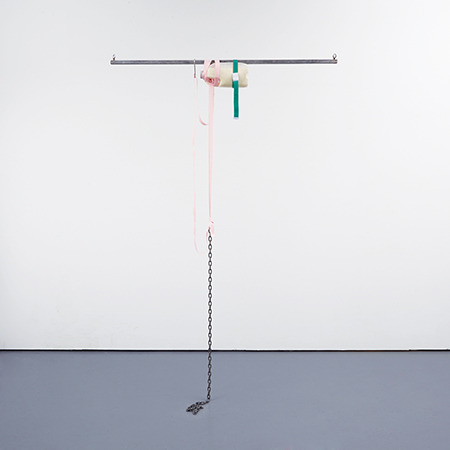Domesticity vs. Boxing

A text on Jesse Darling’s sculptures, written for The Conch at the South London Gallery last Spring.
Whatever is something for Jesse Darling’s work. Isn’t work opposed to whatever? Whatever is supposed to be lazy, don’t care, not full of laboursome love. Jesse writes of art as love practice writing as love practice… Jesse also welds, steel, in a serious studio in the arches. JD’s website is called the ‘Brave New Whatever’, which has something of crossing the frontier about it.
Whatever is a horizon of possibilities. Giorgio Agamben said this. Whatever could seem antithetical to theorizing, so I’m not going to do too much of it, apart from to say – on the fly – that Agamben, in his suggestion of “whatever being” – “other ways of belonging” outside of conventional identity – has something for JD, despite and because of this whatever.^
Whatever might afford me some imprecision, but whatever from JD’s POV is the shrugging off of any category anyone might put on art (/life) because nothing there feels like it fits. This makes my work harder.
In The Coming Community, Agamben translates the Latin “whatever” Quodlibet ens not only as “being, it does not matter which” – that kind of Clueless, American indifference – but, “being such that it always matters.”^^
The thing of regarding an artist’s work as separate from the artist, it doesn’t exist easily with Jesse. This is usual for artists who use their own bodies, and/or digital presences, but less usual for a sculptor. For example, I like the pair of boxing bags Jesse made with Takeshi Shiomitsu for the exhibition “Spirit Level” at AND/OR gallery – hanging, weighted, in limbo – but I can’t tell if I like them more because Jesse made them, and because the work speaks of the artists’ strength, or not.
Love, or whatever, is not about liking specific aspects of the object, or about adoring its universals (said Agamben), but about a feeling for its situation of being as such.
JD said of the provisional IKEA-conspired installation at Arcadia_Missa “Stockholm Syndrome and Other System Failures” that it wasn’t as much about single works as about the “collateral damage… material, financial, emotional” of making work as a (fragmented) whole; that the broom, the tools, the paint pot left on site were “an analogue for the subject in the world. Maybe even a self-portrait.”^^^
Bound in black straps, on a chain, in pink PVC – along with Hit Piece, a rectangle of drywall bashed in – the suspended balance of the pair of boxing bags packs a satisfying (if insecure?) punch.
This kind of whatever is a hard-working manual manoeuvre. A lite T-shape structure is composed of a steel bar, a metal hook and a milk bottle (soy, obv.), attached with a green belt and a cotton ribbon. Another chain trails to the ground. It’s a seemingly secured situation, a cleaner form than the chipboard shelters and plywood frame facades: minimal contemporary povera. I think of the bottle of milk falling from its brace, spraying the sterile gallery with pasteurised liquid, creamy puddles over the smooth grey floor.
These sculptures speak of everyday bondage, and not only the materials, but the lived experience of art beyond our means. Home Unit plays at home-making in impossible circumstances, an architecture of polystyrene blocks and MDF. It’s built according to the predicament that “home is an idea that needs maintenance, rather than a place or a commodity,” but also that “domesticity is terrifying.”^^^^ On wheels, it is – like the successful artist’s lifestyle – portable, and only just still standing.
Wounded Door1 has an awkward frame, a single wheel, not quite enough to roll away. The steel’s bent limbs are structurally defenceless, sort-of failing, asymmetric misfits. The crippled portal leads to a kind of community, that advocated by JD and by Agamben as a “co-belonging of singularities,”^^^^^ wedged in a precarious reality. The labour of making metal sculpture contains a realism too: the forms produced are representational not in terms of a visual likeness to reality, but in the sense of working hard to stand for something – whatever that may be.
^ McKenzie Wark reading Jodi Dean on Agamben, ‘Communicative Capitalism’.
^^ http://zinelibrary.info/files/comingcommunity.pdf
^^^ Darling in interview with Giampaolo Bianconi in Rhizome.
^^^^ Darling on The Kitson Road Living Project in Dazed. ‘A lesson in living together’; JD tweet paraphrase.
^^^^^ Catherine Mills, The Philosophy of Agamben (Oxford: Routledge, 2014), 130.